HOS203A: Food and Beverage Management Report - Takeaway Burgers
VerifiedAdded on 2023/01/20
|13
|2689
|34
Report
AI Summary
This report provides a comprehensive analysis of the food and beverage (FAB) management of a takeaway burger restaurant. It begins with an executive summary and introduction outlining the scope of the report, which includes identifying the target market, developing a new FAB concept, and determining an appropriate style of service. The report then delves into the evaluation of operational figures, proposing two financial controls to enhance profitability. Furthermore, it explores improvements in operations by examining the food service cycle and suggesting enhancements to cost and revenue control, as well as consumer satisfaction monitoring. The report also includes an outline and categorization of the supplier segment based on Kraljic’s Classification, evaluating the role of supply management practices within the context of the restaurant's operations. The report concludes with a summary of key findings and recommendations.
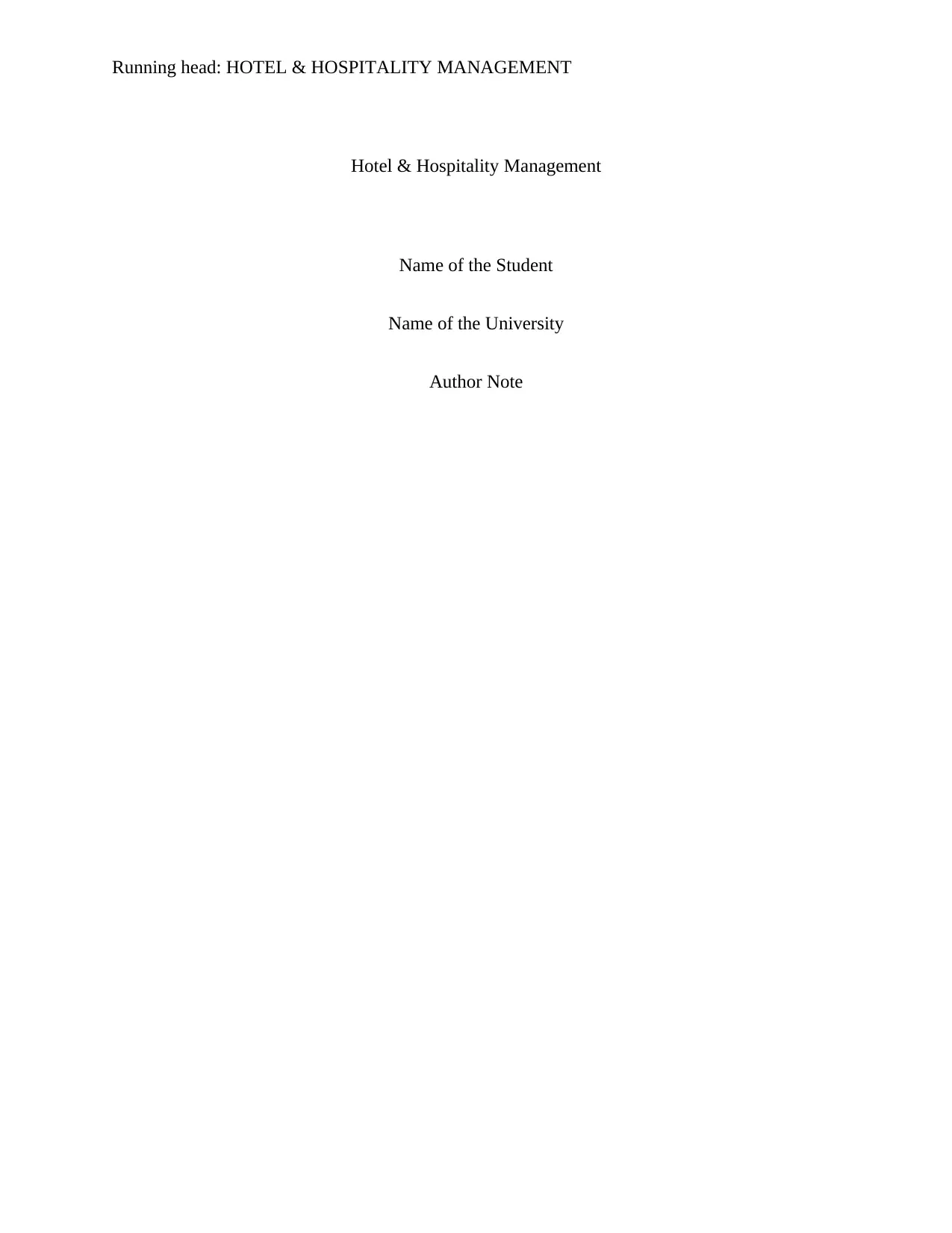
Running head: HOTEL & HOSPITALITY MANAGEMENT
Hotel & Hospitality Management
Name of the Student
Name of the University
Author Note
Hotel & Hospitality Management
Name of the Student
Name of the University
Author Note
Paraphrase This Document
Need a fresh take? Get an instant paraphrase of this document with our AI Paraphraser
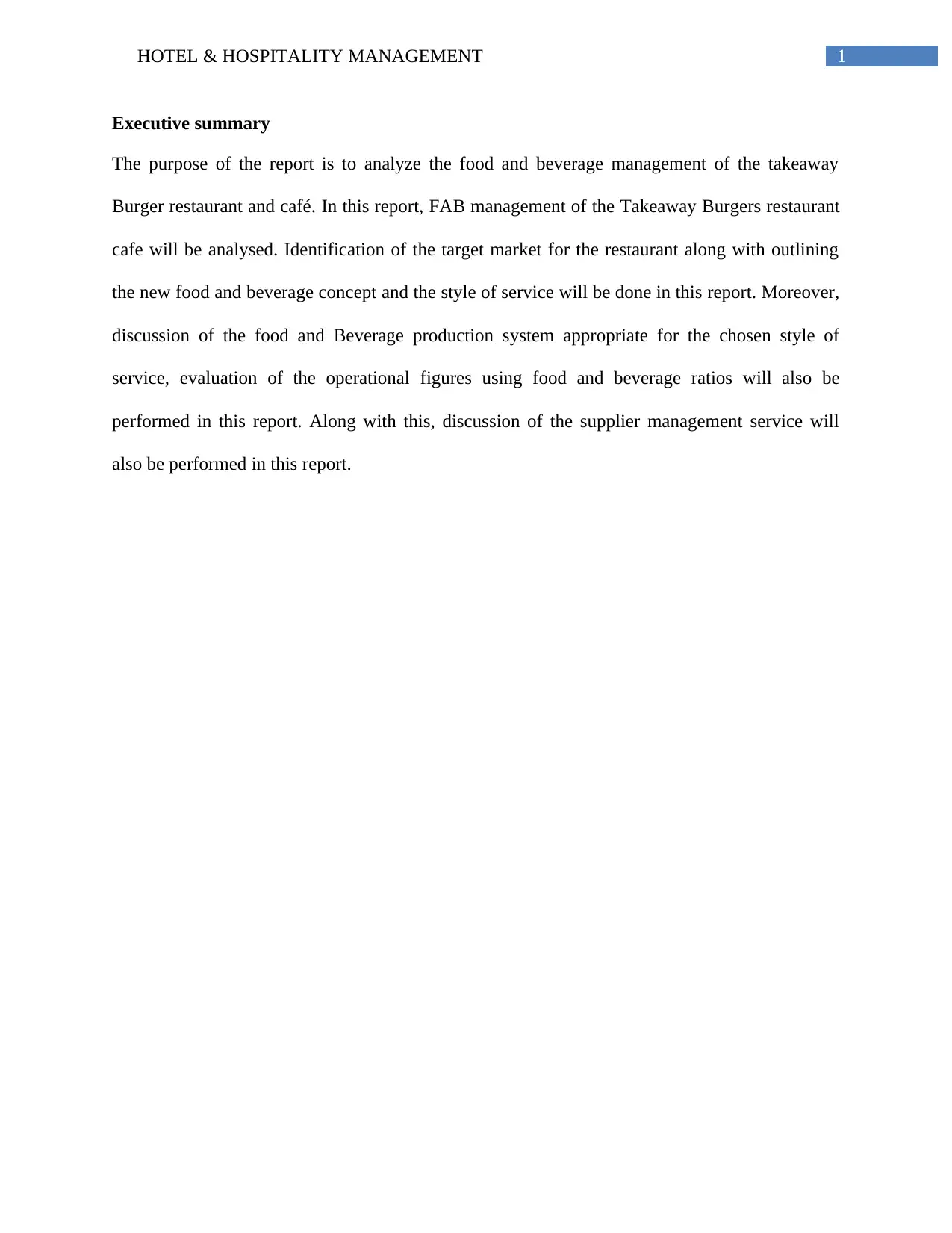
1HOTEL & HOSPITALITY MANAGEMENT
Executive summary
The purpose of the report is to analyze the food and beverage management of the takeaway
Burger restaurant and café. In this report, FAB management of the Takeaway Burgers restaurant
cafe will be analysed. Identification of the target market for the restaurant along with outlining
the new food and beverage concept and the style of service will be done in this report. Moreover,
discussion of the food and Beverage production system appropriate for the chosen style of
service, evaluation of the operational figures using food and beverage ratios will also be
performed in this report. Along with this, discussion of the supplier management service will
also be performed in this report.
Executive summary
The purpose of the report is to analyze the food and beverage management of the takeaway
Burger restaurant and café. In this report, FAB management of the Takeaway Burgers restaurant
cafe will be analysed. Identification of the target market for the restaurant along with outlining
the new food and beverage concept and the style of service will be done in this report. Moreover,
discussion of the food and Beverage production system appropriate for the chosen style of
service, evaluation of the operational figures using food and beverage ratios will also be
performed in this report. Along with this, discussion of the supplier management service will
also be performed in this report.
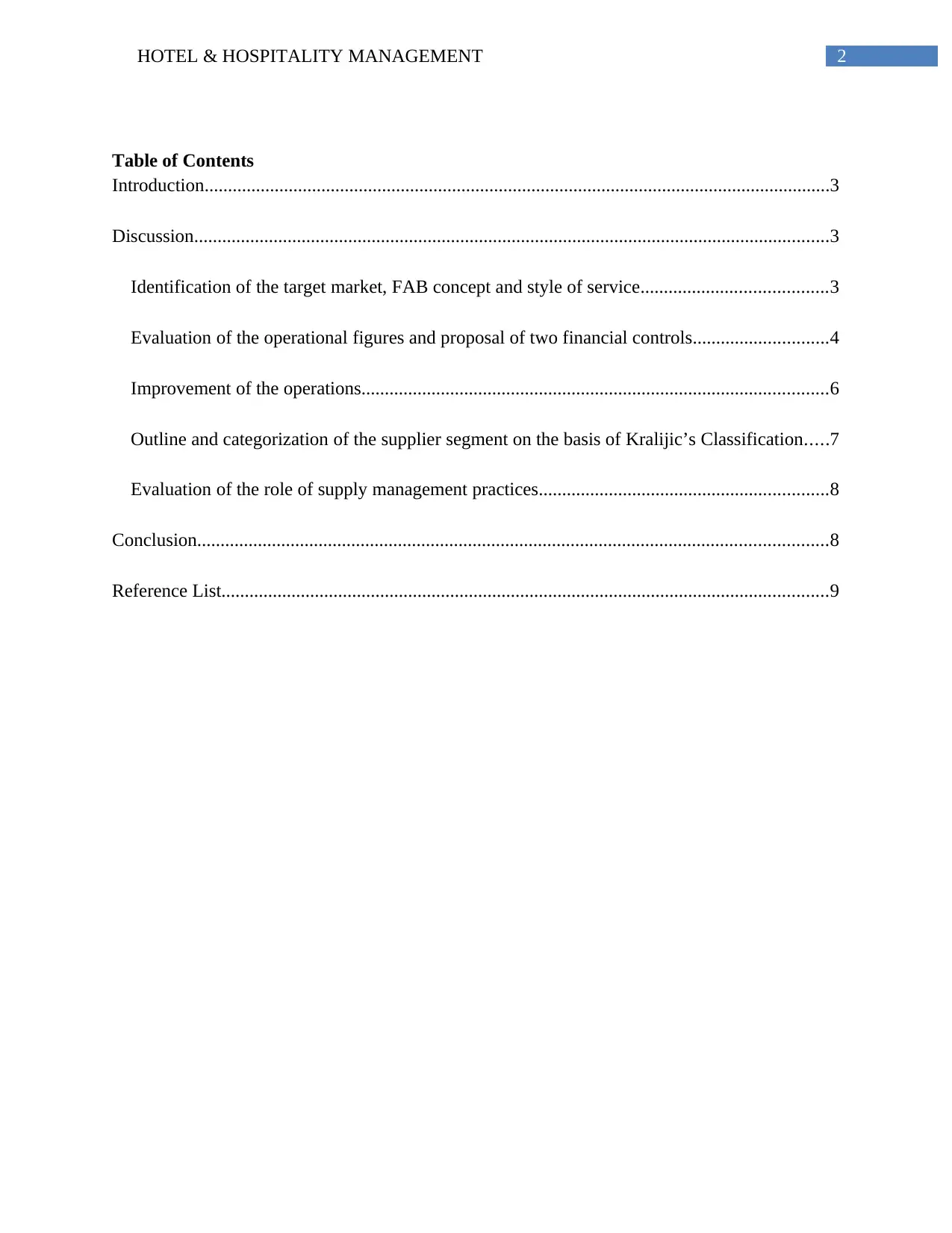
2HOTEL & HOSPITALITY MANAGEMENT
Table of Contents
Introduction......................................................................................................................................3
Discussion........................................................................................................................................3
Identification of the target market, FAB concept and style of service........................................3
Evaluation of the operational figures and proposal of two financial controls.............................4
Improvement of the operations....................................................................................................6
Outline and categorization of the supplier segment on the basis of Kralijic’s Classification.....7
Evaluation of the role of supply management practices..............................................................8
Conclusion.......................................................................................................................................8
Reference List..................................................................................................................................9
Table of Contents
Introduction......................................................................................................................................3
Discussion........................................................................................................................................3
Identification of the target market, FAB concept and style of service........................................3
Evaluation of the operational figures and proposal of two financial controls.............................4
Improvement of the operations....................................................................................................6
Outline and categorization of the supplier segment on the basis of Kralijic’s Classification.....7
Evaluation of the role of supply management practices..............................................................8
Conclusion.......................................................................................................................................8
Reference List..................................................................................................................................9
⊘ This is a preview!⊘
Do you want full access?
Subscribe today to unlock all pages.

Trusted by 1+ million students worldwide
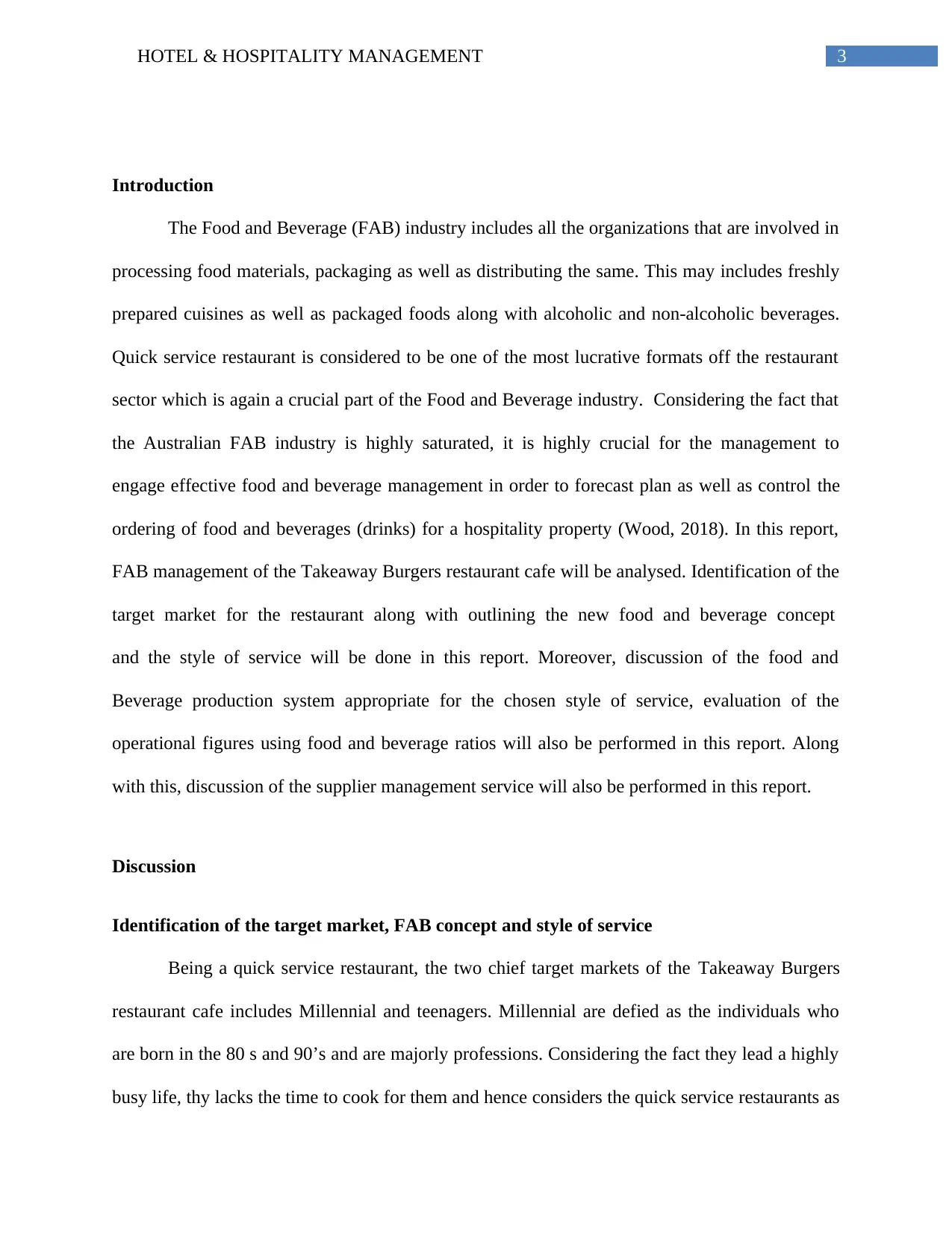
3HOTEL & HOSPITALITY MANAGEMENT
Introduction
The Food and Beverage (FAB) industry includes all the organizations that are involved in
processing food materials, packaging as well as distributing the same. This may includes freshly
prepared cuisines as well as packaged foods along with alcoholic and non-alcoholic beverages.
Quick service restaurant is considered to be one of the most lucrative formats off the restaurant
sector which is again a crucial part of the Food and Beverage industry. Considering the fact that
the Australian FAB industry is highly saturated, it is highly crucial for the management to
engage effective food and beverage management in order to forecast plan as well as control the
ordering of food and beverages (drinks) for a hospitality property (Wood, 2018). In this report,
FAB management of the Takeaway Burgers restaurant cafe will be analysed. Identification of the
target market for the restaurant along with outlining the new food and beverage concept
and the style of service will be done in this report. Moreover, discussion of the food and
Beverage production system appropriate for the chosen style of service, evaluation of the
operational figures using food and beverage ratios will also be performed in this report. Along
with this, discussion of the supplier management service will also be performed in this report.
Discussion
Identification of the target market, FAB concept and style of service
Being a quick service restaurant, the two chief target markets of the Takeaway Burgers
restaurant cafe includes Millennial and teenagers. Millennial are defied as the individuals who
are born in the 80 s and 90’s and are majorly professions. Considering the fact they lead a highly
busy life, thy lacks the time to cook for them and hence considers the quick service restaurants as
Introduction
The Food and Beverage (FAB) industry includes all the organizations that are involved in
processing food materials, packaging as well as distributing the same. This may includes freshly
prepared cuisines as well as packaged foods along with alcoholic and non-alcoholic beverages.
Quick service restaurant is considered to be one of the most lucrative formats off the restaurant
sector which is again a crucial part of the Food and Beverage industry. Considering the fact that
the Australian FAB industry is highly saturated, it is highly crucial for the management to
engage effective food and beverage management in order to forecast plan as well as control the
ordering of food and beverages (drinks) for a hospitality property (Wood, 2018). In this report,
FAB management of the Takeaway Burgers restaurant cafe will be analysed. Identification of the
target market for the restaurant along with outlining the new food and beverage concept
and the style of service will be done in this report. Moreover, discussion of the food and
Beverage production system appropriate for the chosen style of service, evaluation of the
operational figures using food and beverage ratios will also be performed in this report. Along
with this, discussion of the supplier management service will also be performed in this report.
Discussion
Identification of the target market, FAB concept and style of service
Being a quick service restaurant, the two chief target markets of the Takeaway Burgers
restaurant cafe includes Millennial and teenagers. Millennial are defied as the individuals who
are born in the 80 s and 90’s and are majorly professions. Considering the fact they lead a highly
busy life, thy lacks the time to cook for them and hence considers the quick service restaurants as
Paraphrase This Document
Need a fresh take? Get an instant paraphrase of this document with our AI Paraphraser
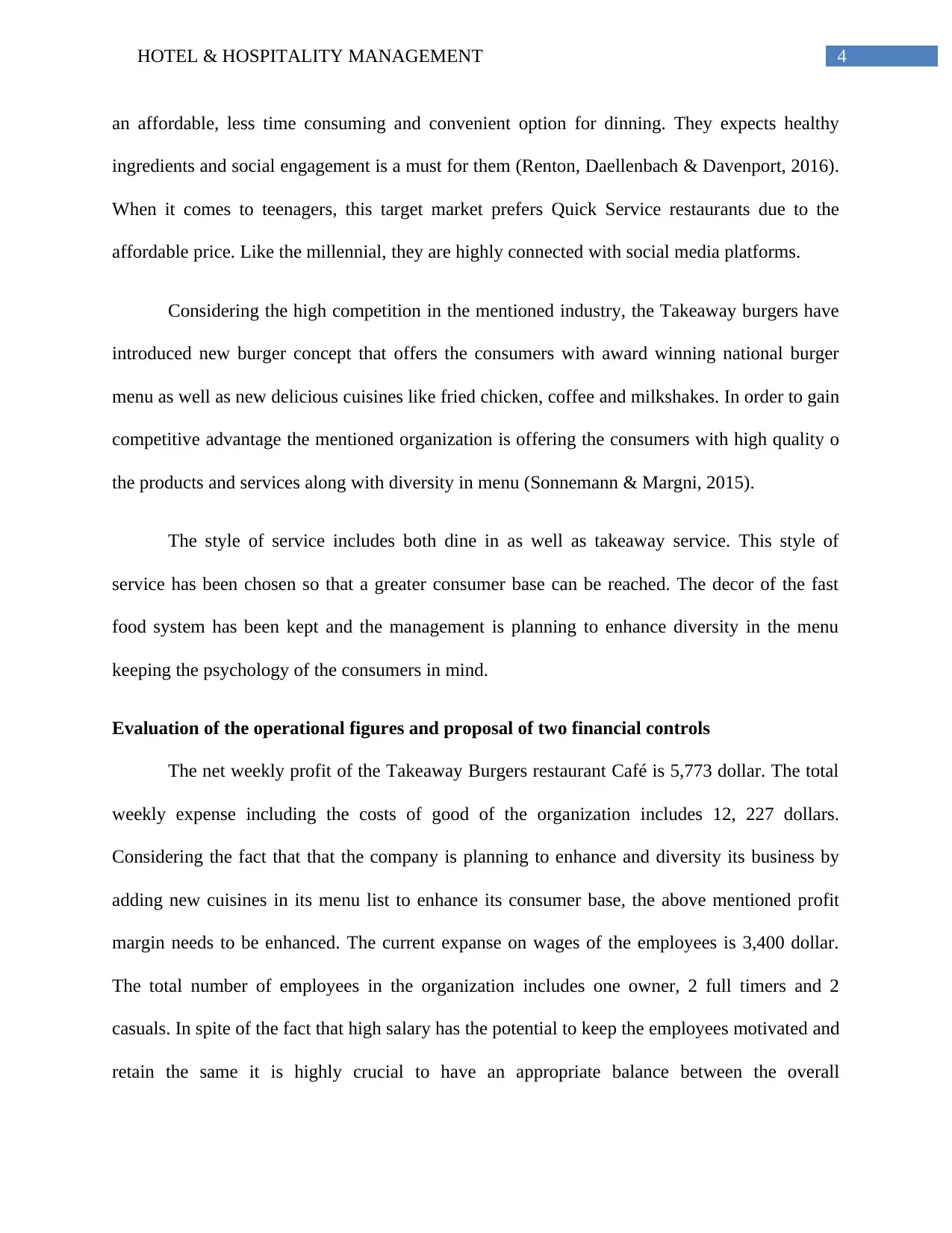
4HOTEL & HOSPITALITY MANAGEMENT
an affordable, less time consuming and convenient option for dinning. They expects healthy
ingredients and social engagement is a must for them (Renton, Daellenbach & Davenport, 2016).
When it comes to teenagers, this target market prefers Quick Service restaurants due to the
affordable price. Like the millennial, they are highly connected with social media platforms.
Considering the high competition in the mentioned industry, the Takeaway burgers have
introduced new burger concept that offers the consumers with award winning national burger
menu as well as new delicious cuisines like fried chicken, coffee and milkshakes. In order to gain
competitive advantage the mentioned organization is offering the consumers with high quality o
the products and services along with diversity in menu (Sonnemann & Margni, 2015).
The style of service includes both dine in as well as takeaway service. This style of
service has been chosen so that a greater consumer base can be reached. The decor of the fast
food system has been kept and the management is planning to enhance diversity in the menu
keeping the psychology of the consumers in mind.
Evaluation of the operational figures and proposal of two financial controls
The net weekly profit of the Takeaway Burgers restaurant Café is 5,773 dollar. The total
weekly expense including the costs of good of the organization includes 12, 227 dollars.
Considering the fact that that the company is planning to enhance and diversity its business by
adding new cuisines in its menu list to enhance its consumer base, the above mentioned profit
margin needs to be enhanced. The current expanse on wages of the employees is 3,400 dollar.
The total number of employees in the organization includes one owner, 2 full timers and 2
casuals. In spite of the fact that high salary has the potential to keep the employees motivated and
retain the same it is highly crucial to have an appropriate balance between the overall
an affordable, less time consuming and convenient option for dinning. They expects healthy
ingredients and social engagement is a must for them (Renton, Daellenbach & Davenport, 2016).
When it comes to teenagers, this target market prefers Quick Service restaurants due to the
affordable price. Like the millennial, they are highly connected with social media platforms.
Considering the high competition in the mentioned industry, the Takeaway burgers have
introduced new burger concept that offers the consumers with award winning national burger
menu as well as new delicious cuisines like fried chicken, coffee and milkshakes. In order to gain
competitive advantage the mentioned organization is offering the consumers with high quality o
the products and services along with diversity in menu (Sonnemann & Margni, 2015).
The style of service includes both dine in as well as takeaway service. This style of
service has been chosen so that a greater consumer base can be reached. The decor of the fast
food system has been kept and the management is planning to enhance diversity in the menu
keeping the psychology of the consumers in mind.
Evaluation of the operational figures and proposal of two financial controls
The net weekly profit of the Takeaway Burgers restaurant Café is 5,773 dollar. The total
weekly expense including the costs of good of the organization includes 12, 227 dollars.
Considering the fact that that the company is planning to enhance and diversity its business by
adding new cuisines in its menu list to enhance its consumer base, the above mentioned profit
margin needs to be enhanced. The current expanse on wages of the employees is 3,400 dollar.
The total number of employees in the organization includes one owner, 2 full timers and 2
casuals. In spite of the fact that high salary has the potential to keep the employees motivated and
retain the same it is highly crucial to have an appropriate balance between the overall
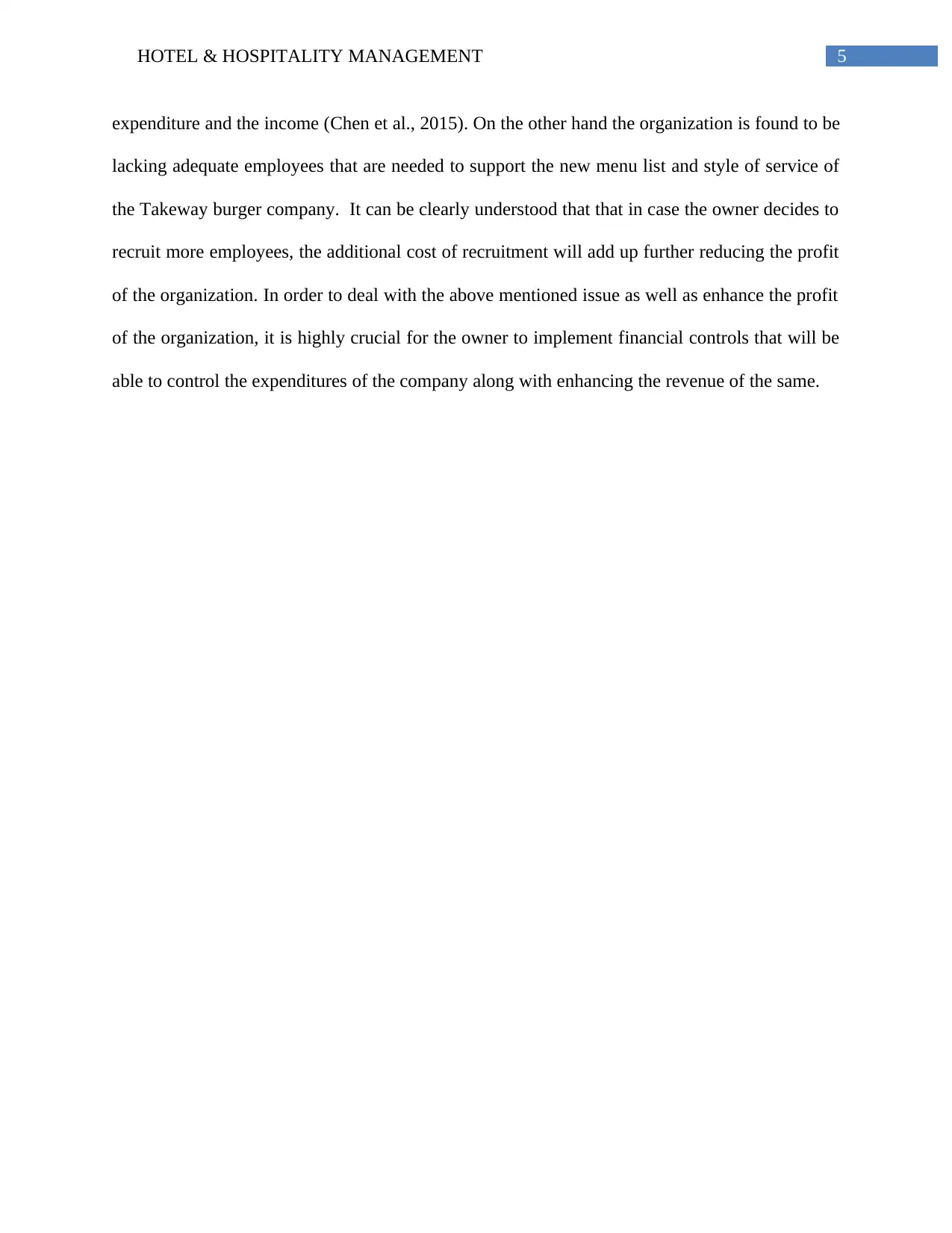
5HOTEL & HOSPITALITY MANAGEMENT
expenditure and the income (Chen et al., 2015). On the other hand the organization is found to be
lacking adequate employees that are needed to support the new menu list and style of service of
the Takeway burger company. It can be clearly understood that that in case the owner decides to
recruit more employees, the additional cost of recruitment will add up further reducing the profit
of the organization. In order to deal with the above mentioned issue as well as enhance the profit
of the organization, it is highly crucial for the owner to implement financial controls that will be
able to control the expenditures of the company along with enhancing the revenue of the same.
expenditure and the income (Chen et al., 2015). On the other hand the organization is found to be
lacking adequate employees that are needed to support the new menu list and style of service of
the Takeway burger company. It can be clearly understood that that in case the owner decides to
recruit more employees, the additional cost of recruitment will add up further reducing the profit
of the organization. In order to deal with the above mentioned issue as well as enhance the profit
of the organization, it is highly crucial for the owner to implement financial controls that will be
able to control the expenditures of the company along with enhancing the revenue of the same.
⊘ This is a preview!⊘
Do you want full access?
Subscribe today to unlock all pages.

Trusted by 1+ million students worldwide
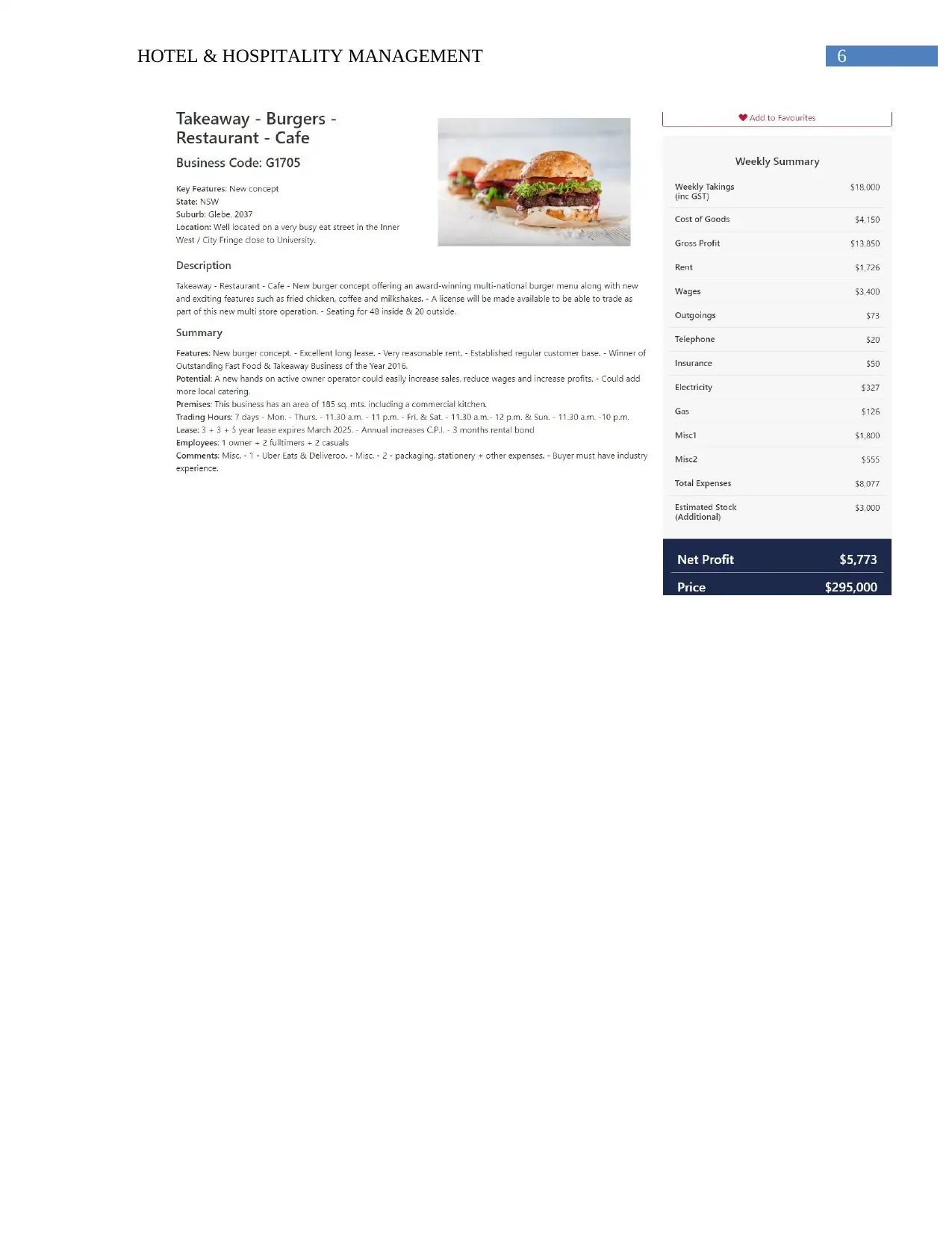
6HOTEL & HOSPITALITY MANAGEMENT
Paraphrase This Document
Need a fresh take? Get an instant paraphrase of this document with our AI Paraphraser
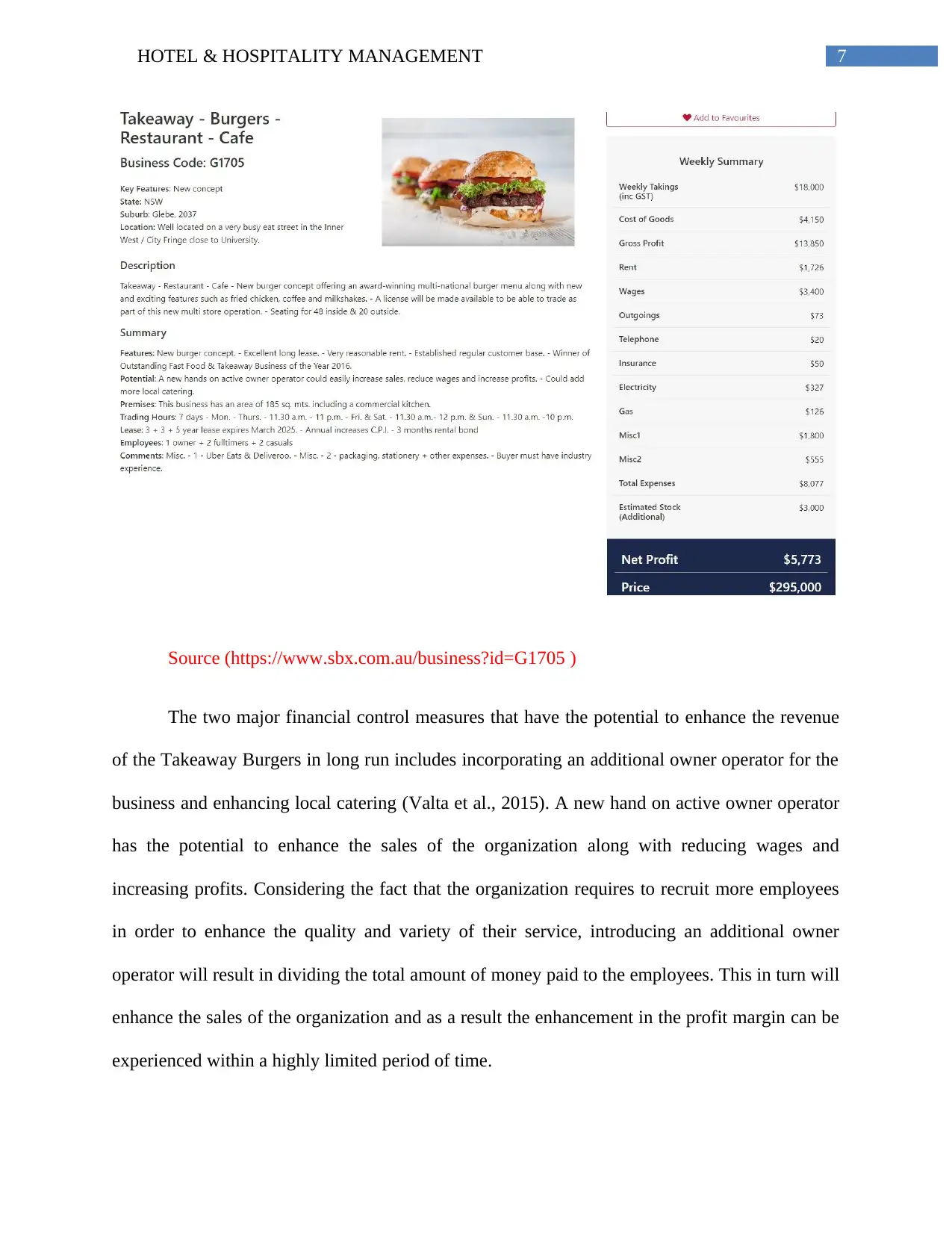
7HOTEL & HOSPITALITY MANAGEMENT
Source (https://www.sbx.com.au/business?id=G1705 )
The two major financial control measures that have the potential to enhance the revenue
of the Takeaway Burgers in long run includes incorporating an additional owner operator for the
business and enhancing local catering (Valta et al., 2015). A new hand on active owner operator
has the potential to enhance the sales of the organization along with reducing wages and
increasing profits. Considering the fact that the organization requires to recruit more employees
in order to enhance the quality and variety of their service, introducing an additional owner
operator will result in dividing the total amount of money paid to the employees. This in turn will
enhance the sales of the organization and as a result the enhancement in the profit margin can be
experienced within a highly limited period of time.
Source (https://www.sbx.com.au/business?id=G1705 )
The two major financial control measures that have the potential to enhance the revenue
of the Takeaway Burgers in long run includes incorporating an additional owner operator for the
business and enhancing local catering (Valta et al., 2015). A new hand on active owner operator
has the potential to enhance the sales of the organization along with reducing wages and
increasing profits. Considering the fact that the organization requires to recruit more employees
in order to enhance the quality and variety of their service, introducing an additional owner
operator will result in dividing the total amount of money paid to the employees. This in turn will
enhance the sales of the organization and as a result the enhancement in the profit margin can be
experienced within a highly limited period of time.
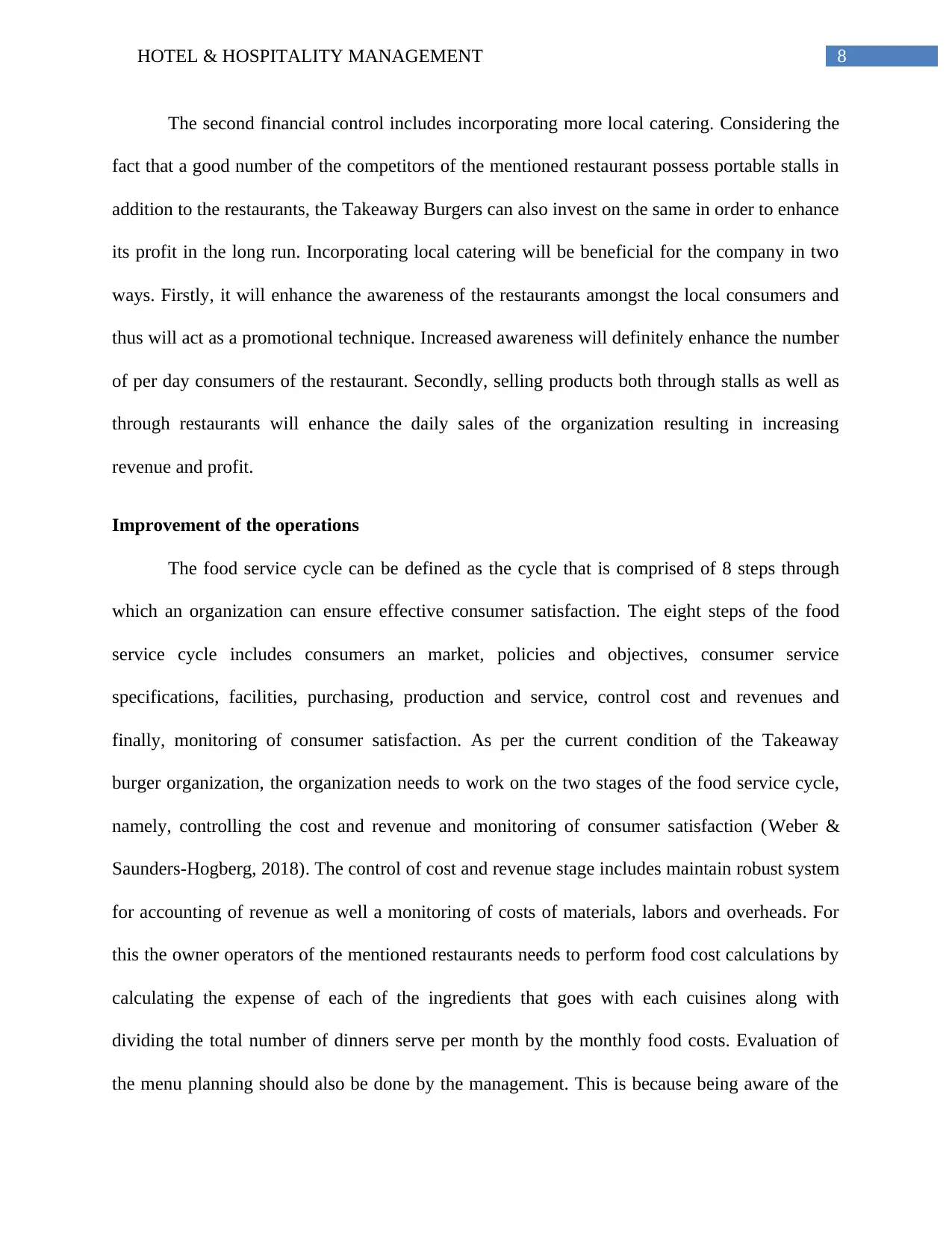
8HOTEL & HOSPITALITY MANAGEMENT
The second financial control includes incorporating more local catering. Considering the
fact that a good number of the competitors of the mentioned restaurant possess portable stalls in
addition to the restaurants, the Takeaway Burgers can also invest on the same in order to enhance
its profit in the long run. Incorporating local catering will be beneficial for the company in two
ways. Firstly, it will enhance the awareness of the restaurants amongst the local consumers and
thus will act as a promotional technique. Increased awareness will definitely enhance the number
of per day consumers of the restaurant. Secondly, selling products both through stalls as well as
through restaurants will enhance the daily sales of the organization resulting in increasing
revenue and profit.
Improvement of the operations
The food service cycle can be defined as the cycle that is comprised of 8 steps through
which an organization can ensure effective consumer satisfaction. The eight steps of the food
service cycle includes consumers an market, policies and objectives, consumer service
specifications, facilities, purchasing, production and service, control cost and revenues and
finally, monitoring of consumer satisfaction. As per the current condition of the Takeaway
burger organization, the organization needs to work on the two stages of the food service cycle,
namely, controlling the cost and revenue and monitoring of consumer satisfaction (Weber &
Saunders-Hogberg, 2018). The control of cost and revenue stage includes maintain robust system
for accounting of revenue as well a monitoring of costs of materials, labors and overheads. For
this the owner operators of the mentioned restaurants needs to perform food cost calculations by
calculating the expense of each of the ingredients that goes with each cuisines along with
dividing the total number of dinners serve per month by the monthly food costs. Evaluation of
the menu planning should also be done by the management. This is because being aware of the
The second financial control includes incorporating more local catering. Considering the
fact that a good number of the competitors of the mentioned restaurant possess portable stalls in
addition to the restaurants, the Takeaway Burgers can also invest on the same in order to enhance
its profit in the long run. Incorporating local catering will be beneficial for the company in two
ways. Firstly, it will enhance the awareness of the restaurants amongst the local consumers and
thus will act as a promotional technique. Increased awareness will definitely enhance the number
of per day consumers of the restaurant. Secondly, selling products both through stalls as well as
through restaurants will enhance the daily sales of the organization resulting in increasing
revenue and profit.
Improvement of the operations
The food service cycle can be defined as the cycle that is comprised of 8 steps through
which an organization can ensure effective consumer satisfaction. The eight steps of the food
service cycle includes consumers an market, policies and objectives, consumer service
specifications, facilities, purchasing, production and service, control cost and revenues and
finally, monitoring of consumer satisfaction. As per the current condition of the Takeaway
burger organization, the organization needs to work on the two stages of the food service cycle,
namely, controlling the cost and revenue and monitoring of consumer satisfaction (Weber &
Saunders-Hogberg, 2018). The control of cost and revenue stage includes maintain robust system
for accounting of revenue as well a monitoring of costs of materials, labors and overheads. For
this the owner operators of the mentioned restaurants needs to perform food cost calculations by
calculating the expense of each of the ingredients that goes with each cuisines along with
dividing the total number of dinners serve per month by the monthly food costs. Evaluation of
the menu planning should also be done by the management. This is because being aware of the
⊘ This is a preview!⊘
Do you want full access?
Subscribe today to unlock all pages.

Trusted by 1+ million students worldwide
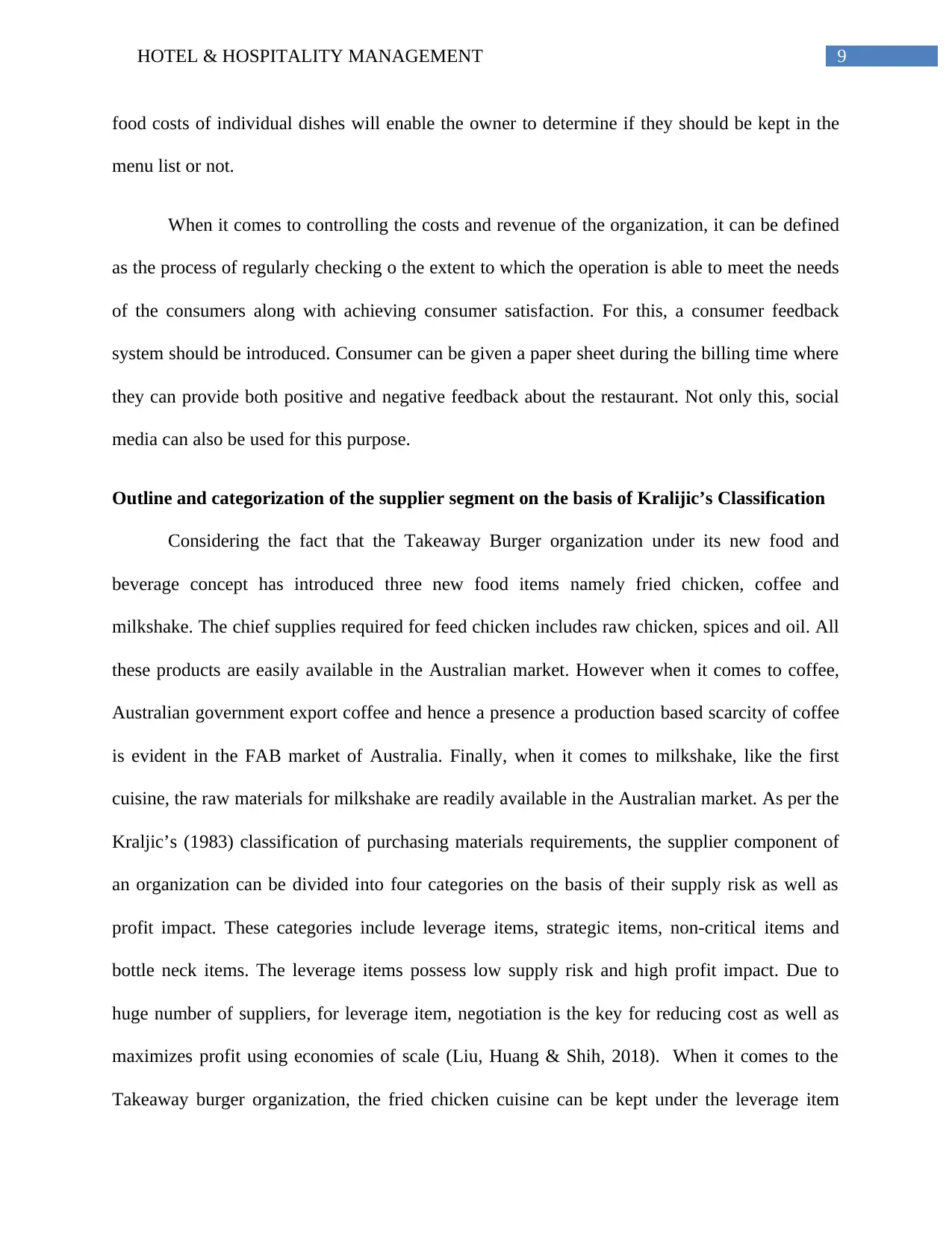
9HOTEL & HOSPITALITY MANAGEMENT
food costs of individual dishes will enable the owner to determine if they should be kept in the
menu list or not.
When it comes to controlling the costs and revenue of the organization, it can be defined
as the process of regularly checking o the extent to which the operation is able to meet the needs
of the consumers along with achieving consumer satisfaction. For this, a consumer feedback
system should be introduced. Consumer can be given a paper sheet during the billing time where
they can provide both positive and negative feedback about the restaurant. Not only this, social
media can also be used for this purpose.
Outline and categorization of the supplier segment on the basis of Kralijic’s Classification
Considering the fact that the Takeaway Burger organization under its new food and
beverage concept has introduced three new food items namely fried chicken, coffee and
milkshake. The chief supplies required for feed chicken includes raw chicken, spices and oil. All
these products are easily available in the Australian market. However when it comes to coffee,
Australian government export coffee and hence a presence a production based scarcity of coffee
is evident in the FAB market of Australia. Finally, when it comes to milkshake, like the first
cuisine, the raw materials for milkshake are readily available in the Australian market. As per the
Kraljic’s (1983) classification of purchasing materials requirements, the supplier component of
an organization can be divided into four categories on the basis of their supply risk as well as
profit impact. These categories include leverage items, strategic items, non-critical items and
bottle neck items. The leverage items possess low supply risk and high profit impact. Due to
huge number of suppliers, for leverage item, negotiation is the key for reducing cost as well as
maximizes profit using economies of scale (Liu, Huang & Shih, 2018). When it comes to the
Takeaway burger organization, the fried chicken cuisine can be kept under the leverage item
food costs of individual dishes will enable the owner to determine if they should be kept in the
menu list or not.
When it comes to controlling the costs and revenue of the organization, it can be defined
as the process of regularly checking o the extent to which the operation is able to meet the needs
of the consumers along with achieving consumer satisfaction. For this, a consumer feedback
system should be introduced. Consumer can be given a paper sheet during the billing time where
they can provide both positive and negative feedback about the restaurant. Not only this, social
media can also be used for this purpose.
Outline and categorization of the supplier segment on the basis of Kralijic’s Classification
Considering the fact that the Takeaway Burger organization under its new food and
beverage concept has introduced three new food items namely fried chicken, coffee and
milkshake. The chief supplies required for feed chicken includes raw chicken, spices and oil. All
these products are easily available in the Australian market. However when it comes to coffee,
Australian government export coffee and hence a presence a production based scarcity of coffee
is evident in the FAB market of Australia. Finally, when it comes to milkshake, like the first
cuisine, the raw materials for milkshake are readily available in the Australian market. As per the
Kraljic’s (1983) classification of purchasing materials requirements, the supplier component of
an organization can be divided into four categories on the basis of their supply risk as well as
profit impact. These categories include leverage items, strategic items, non-critical items and
bottle neck items. The leverage items possess low supply risk and high profit impact. Due to
huge number of suppliers, for leverage item, negotiation is the key for reducing cost as well as
maximizes profit using economies of scale (Liu, Huang & Shih, 2018). When it comes to the
Takeaway burger organization, the fried chicken cuisine can be kept under the leverage item
Paraphrase This Document
Need a fresh take? Get an instant paraphrase of this document with our AI Paraphraser
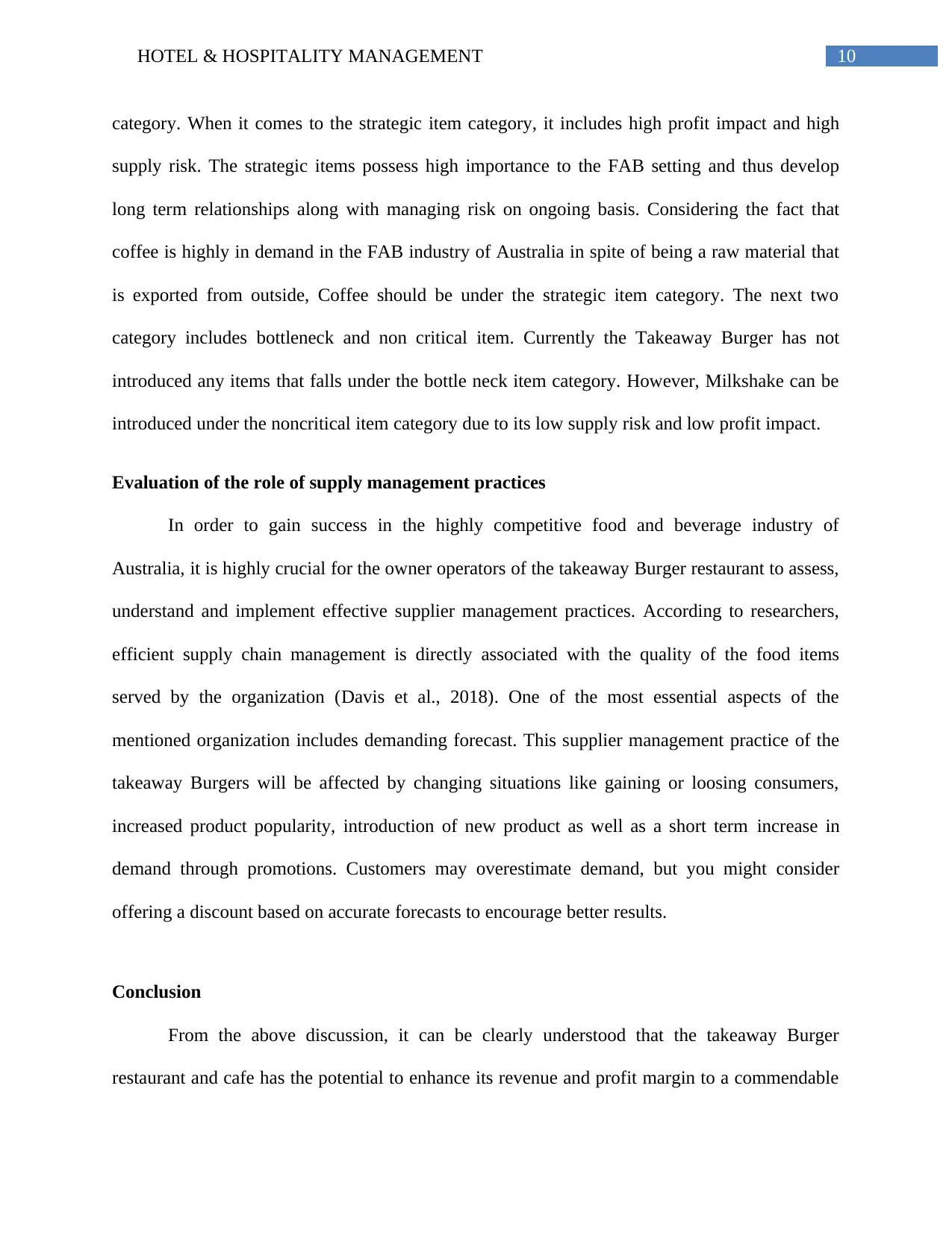
10HOTEL & HOSPITALITY MANAGEMENT
category. When it comes to the strategic item category, it includes high profit impact and high
supply risk. The strategic items possess high importance to the FAB setting and thus develop
long term relationships along with managing risk on ongoing basis. Considering the fact that
coffee is highly in demand in the FAB industry of Australia in spite of being a raw material that
is exported from outside, Coffee should be under the strategic item category. The next two
category includes bottleneck and non critical item. Currently the Takeaway Burger has not
introduced any items that falls under the bottle neck item category. However, Milkshake can be
introduced under the noncritical item category due to its low supply risk and low profit impact.
Evaluation of the role of supply management practices
In order to gain success in the highly competitive food and beverage industry of
Australia, it is highly crucial for the owner operators of the takeaway Burger restaurant to assess,
understand and implement effective supplier management practices. According to researchers,
efficient supply chain management is directly associated with the quality of the food items
served by the organization (Davis et al., 2018). One of the most essential aspects of the
mentioned organization includes demanding forecast. This supplier management practice of the
takeaway Burgers will be affected by changing situations like gaining or loosing consumers,
increased product popularity, introduction of new product as well as a short term increase in
demand through promotions. Customers may overestimate demand, but you might consider
offering a discount based on accurate forecasts to encourage better results.
Conclusion
From the above discussion, it can be clearly understood that the takeaway Burger
restaurant and cafe has the potential to enhance its revenue and profit margin to a commendable
category. When it comes to the strategic item category, it includes high profit impact and high
supply risk. The strategic items possess high importance to the FAB setting and thus develop
long term relationships along with managing risk on ongoing basis. Considering the fact that
coffee is highly in demand in the FAB industry of Australia in spite of being a raw material that
is exported from outside, Coffee should be under the strategic item category. The next two
category includes bottleneck and non critical item. Currently the Takeaway Burger has not
introduced any items that falls under the bottle neck item category. However, Milkshake can be
introduced under the noncritical item category due to its low supply risk and low profit impact.
Evaluation of the role of supply management practices
In order to gain success in the highly competitive food and beverage industry of
Australia, it is highly crucial for the owner operators of the takeaway Burger restaurant to assess,
understand and implement effective supplier management practices. According to researchers,
efficient supply chain management is directly associated with the quality of the food items
served by the organization (Davis et al., 2018). One of the most essential aspects of the
mentioned organization includes demanding forecast. This supplier management practice of the
takeaway Burgers will be affected by changing situations like gaining or loosing consumers,
increased product popularity, introduction of new product as well as a short term increase in
demand through promotions. Customers may overestimate demand, but you might consider
offering a discount based on accurate forecasts to encourage better results.
Conclusion
From the above discussion, it can be clearly understood that the takeaway Burger
restaurant and cafe has the potential to enhance its revenue and profit margin to a commendable
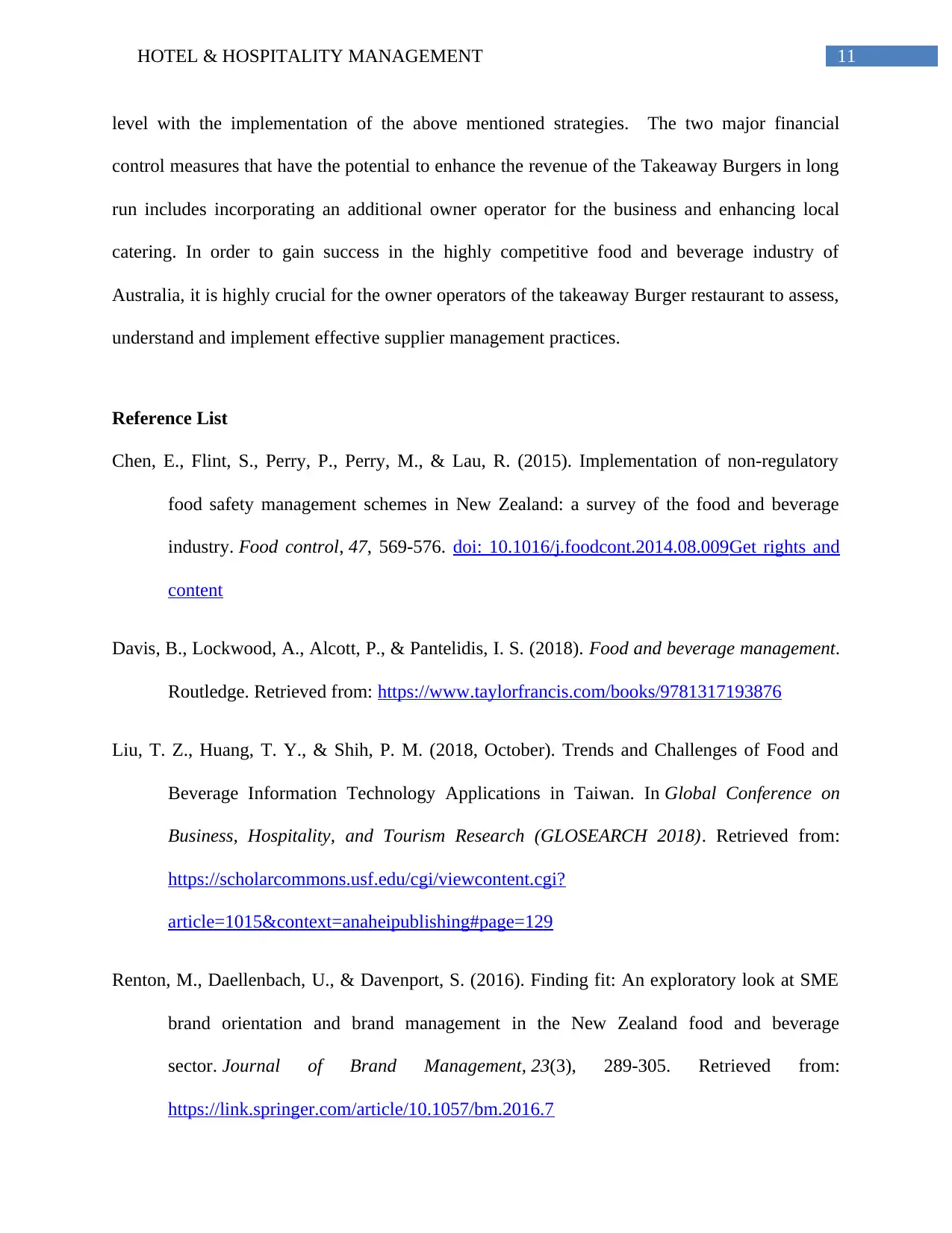
11HOTEL & HOSPITALITY MANAGEMENT
level with the implementation of the above mentioned strategies. The two major financial
control measures that have the potential to enhance the revenue of the Takeaway Burgers in long
run includes incorporating an additional owner operator for the business and enhancing local
catering. In order to gain success in the highly competitive food and beverage industry of
Australia, it is highly crucial for the owner operators of the takeaway Burger restaurant to assess,
understand and implement effective supplier management practices.
Reference List
Chen, E., Flint, S., Perry, P., Perry, M., & Lau, R. (2015). Implementation of non-regulatory
food safety management schemes in New Zealand: a survey of the food and beverage
industry. Food control, 47, 569-576. doi: 10.1016/j.foodcont.2014.08.009Get rights and
content
Davis, B., Lockwood, A., Alcott, P., & Pantelidis, I. S. (2018). Food and beverage management.
Routledge. Retrieved from: https://www.taylorfrancis.com/books/9781317193876
Liu, T. Z., Huang, T. Y., & Shih, P. M. (2018, October). Trends and Challenges of Food and
Beverage Information Technology Applications in Taiwan. In Global Conference on
Business, Hospitality, and Tourism Research (GLOSEARCH 2018). Retrieved from:
https://scholarcommons.usf.edu/cgi/viewcontent.cgi?
article=1015&context=anaheipublishing#page=129
Renton, M., Daellenbach, U., & Davenport, S. (2016). Finding fit: An exploratory look at SME
brand orientation and brand management in the New Zealand food and beverage
sector. Journal of Brand Management, 23(3), 289-305. Retrieved from:
https://link.springer.com/article/10.1057/bm.2016.7
level with the implementation of the above mentioned strategies. The two major financial
control measures that have the potential to enhance the revenue of the Takeaway Burgers in long
run includes incorporating an additional owner operator for the business and enhancing local
catering. In order to gain success in the highly competitive food and beverage industry of
Australia, it is highly crucial for the owner operators of the takeaway Burger restaurant to assess,
understand and implement effective supplier management practices.
Reference List
Chen, E., Flint, S., Perry, P., Perry, M., & Lau, R. (2015). Implementation of non-regulatory
food safety management schemes in New Zealand: a survey of the food and beverage
industry. Food control, 47, 569-576. doi: 10.1016/j.foodcont.2014.08.009Get rights and
content
Davis, B., Lockwood, A., Alcott, P., & Pantelidis, I. S. (2018). Food and beverage management.
Routledge. Retrieved from: https://www.taylorfrancis.com/books/9781317193876
Liu, T. Z., Huang, T. Y., & Shih, P. M. (2018, October). Trends and Challenges of Food and
Beverage Information Technology Applications in Taiwan. In Global Conference on
Business, Hospitality, and Tourism Research (GLOSEARCH 2018). Retrieved from:
https://scholarcommons.usf.edu/cgi/viewcontent.cgi?
article=1015&context=anaheipublishing#page=129
Renton, M., Daellenbach, U., & Davenport, S. (2016). Finding fit: An exploratory look at SME
brand orientation and brand management in the New Zealand food and beverage
sector. Journal of Brand Management, 23(3), 289-305. Retrieved from:
https://link.springer.com/article/10.1057/bm.2016.7
⊘ This is a preview!⊘
Do you want full access?
Subscribe today to unlock all pages.

Trusted by 1+ million students worldwide
1 out of 13
Related Documents
Your All-in-One AI-Powered Toolkit for Academic Success.
+13062052269
info@desklib.com
Available 24*7 on WhatsApp / Email
![[object Object]](/_next/static/media/star-bottom.7253800d.svg)
Unlock your academic potential
Copyright © 2020–2025 A2Z Services. All Rights Reserved. Developed and managed by ZUCOL.





